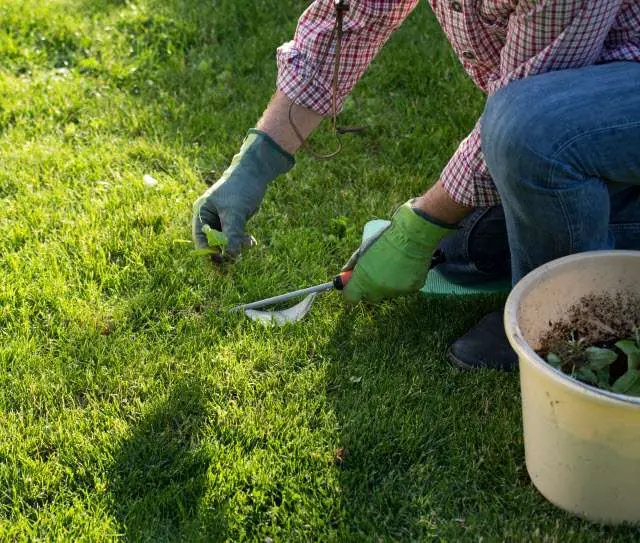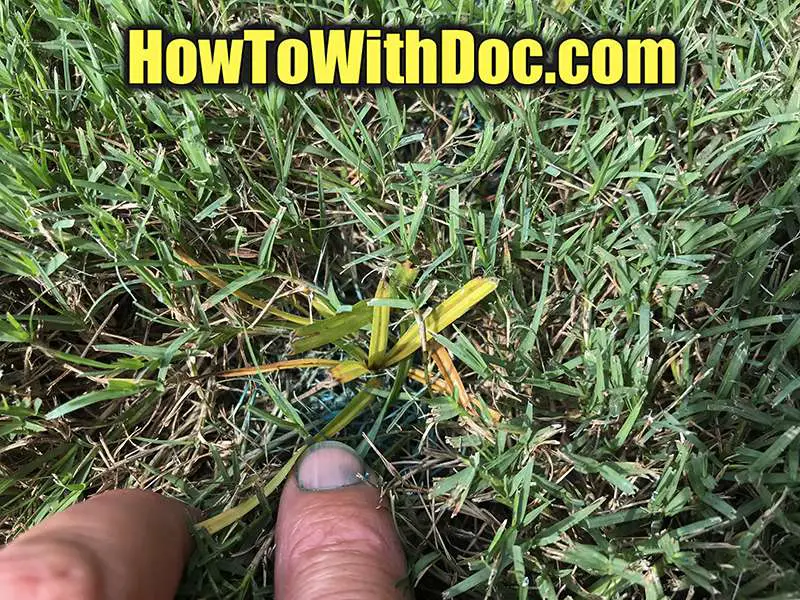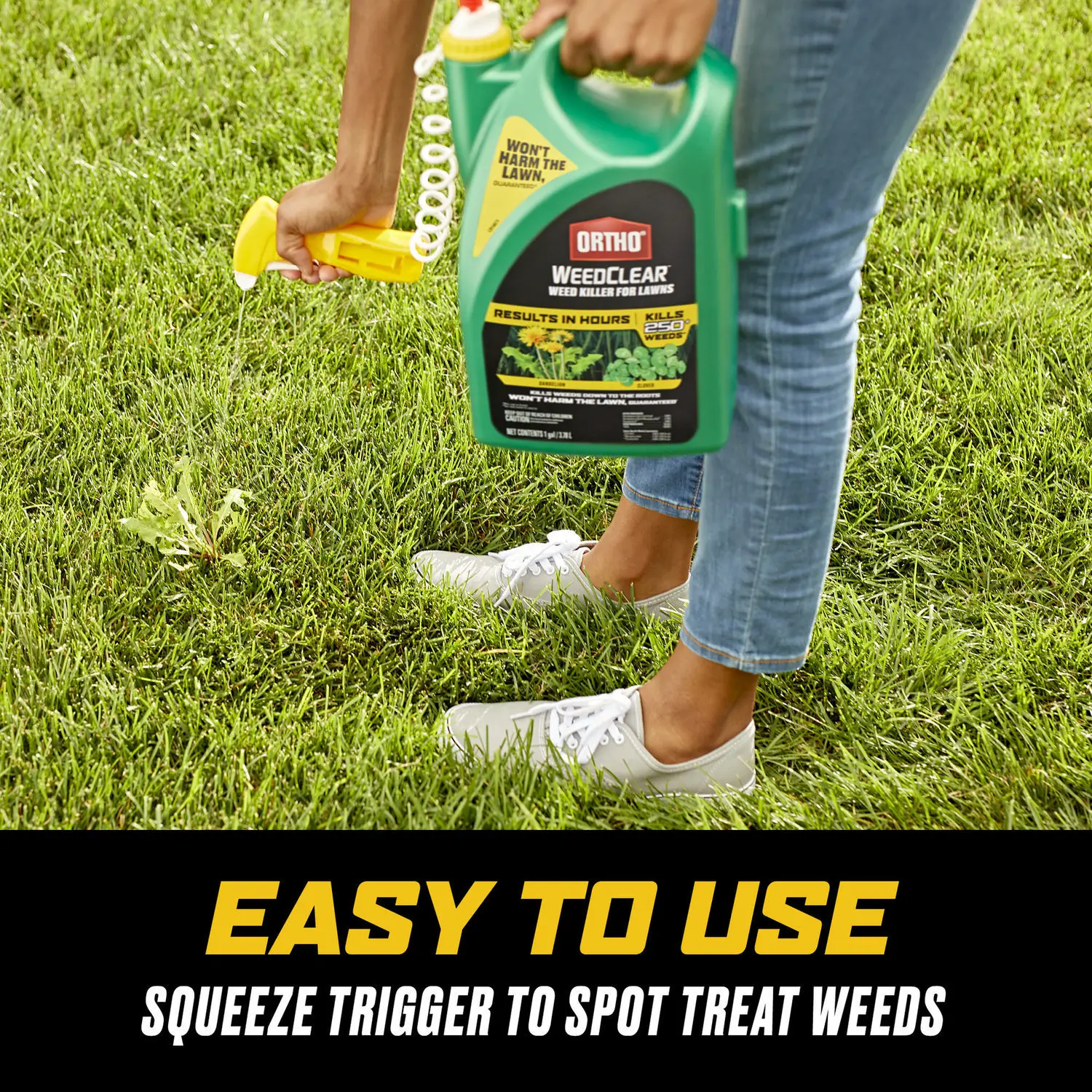Use White Vinegar Direct
While its a crucial ingredient in many of our natural weed killer recipes, spraying vinegar on plants is useful in and of itself. While household vinegar is helpful, we recommend using a product with 20% acetic acid.
Vinegar will kill any plant it comes into contact with, so be very careful where youre spraying.
You May Like: Kid Lawn Mowing Business
Be Realistic About The Work Involved
It takes quite a bit of money, time, and sweat equity to kill a lawn so that you can begin anew.
You should also be aware that certain methods can negatively impact the environment, so keep this in mind when making your decisions and be mindful about how you proceed.
Make sure to find out whether your homeowners association or local environmental agency has any rules with regard to this process.
Also its wise to check-in with your neighbors. Im a big believer that following proper lawn care etiquette and being respectful of the people you live near is worth the time and energy.
You will need to strike a balance between all the competing factors and requirements. This wont be a perfect process, and you cant make everyone happy, but making the effort to do things the right way and to be respectful of your neighbors and the environment is worth doing.
Be aware that you can use a variety of methods when killing a lawn and starting over, and that you use different approaches on different parts of your lawn, depending on your needs and preferences.
Homeowners who have an underground irrigation system should know where all their pipe and sprinkler heads are on the lawn, in order to try to prevent damage during the digging and tilling processes.
Aerate Your Soil Once A Year To Help Prevent Weeds
Recommended Reading: How To Remove Bad Grass From Lawn
Use A Commercial Weed Killer
Sometimes a store-bought weed killer is all you need to eliminate those pesky plants from your yard. One of the most common chemical herbicides is Roundup Weed Killer. The active ingredient in these weed killers is usually Glyphosate, which is applied to the leaves of the plant.
The chemical is then absorbed into the plant, attacking the root systems and killing the weeds. Use either a sprayer for larger sections or a watering can for small patches to administer the product over the affected areas.
Be selective in what locations you use this particular weed killer, however, since it will also kill other plants, including flowers and grass.
Use A Selective Herbicide

You want to choose a weed killer which has been engineered to kill the weed but not that the grass you have. Selective means it won’t kill all plants it’s applied to. 2,4-D is the more common selective herbicide. Using it properly has minimal risks and is extremely effective at killing weeds without killing your grass.
Selective herbicide works by entering the leaf of the weed and changing the way the plant handles nutrients. It causes it to literally grow and age itself to death. Selective herbicides typically take 4-14 days to see very strong results but can literally start to work overnight. It is an effective way to kill 99% of broadleaf weeds down to the root so that the same weed shouldnt be a problem in the future.
If you want to do this yourself the products, we recommend would be either Weed B Gon or Killex. These products can be purchased at a local hardware store such as Home Depot or Lowe’s.
You May Like: Does Lowes Rent Lawn Equipment
How To Get Rid Of Weeds Without Killing Grass
Weeds can be pretty stubborn and controlling them can be a hassle. They mature quickly and multiply and before you know it, they are already stealing the soils water and essential nutrients and getting in the way of the grasss proper blossoming.
One of gardeners biggest problems while digging for a solution to controlling weeds is killing the lawn weeds without killing the rest of the yard. The war against weeds always seems to be an eternal battle. While there are several options to pick from that claim to kill weeds without impacting the health of your grass, whether home remedies or store-bought products, not all work perfectly.
Fortunately, there are foolproof ways to clear these pesky plants. A surefire way is to pull them up manually, and another way is by using certain herbicides. But before running off to your local hardware or garden center, you must first pinpoint the type of weeds in your yard. This will cause you to treat them effectively.
Contents
Other Methods To Get Rid Of Weeds Naturally
When youve got too many lawn weeds to remove one by one, try one of these non-toxic weed killers before reaching for chemicals:
- Use the sun to kill weeds. Cover a large patch of ground with a heavy plastic sheet. Over the course of several weeks, the heat from the sun will kill the weeds underneath.
- Make a weed spray from 1 oz of vodka to 2 cups water or combine 4 cups horticultural vinegar and ¼ cup salt. For both sprays, add a squirt of dish soap to help the spray stick to leaves. Spray the weeds and allow them to dry. Both sprays will work best in full sun.
- Pour boiling water on weeds. This is a great option for weeds in between stepping stones or in cracks in the sidewalk.
- Get a flamethrower . You can purchase a flame weeder from a local garden or hardware store. Be careful not to use this option any time theres a risk of fire and only use it on tender green plants, not on larger, woody plants.
The best form of lawn weed control is a healthy lawn. Some homeowners implement a tactic to overwhelm weeds with healthy grass by overseeding a weedy lawn. If you have exhausted all of these options and are still dealing with a weed problem, you may consider talking to a trusted lawn professional about how to get rid of weeds without killing grass by using chemicals. If you do decide to use a weed killer on your yard, use the lowest concentration product possible.
Recommended Reading: How To Make Your Lawn Thicker
Be Proactive With Your Herbicides
If you are trying to get a jump start on keeping weeds out of your gardens, one thing you can try is a pre-emergent herbicide. Most of your local garden supply stores carry one form of this herbicide or another, though the most popular and effective one to try is prodiamine.
This barrier agent is generally applied as a water-soluble solution that is sprayed over your lawn using a low-pressure setting. Treat your yard with these pre-emergent herbicides at least twice a year. Add once in early springtime and once again at the beginning of fall.
Homemade Weed Killer Safe For Grass
Corn gluten meal is a safe method to apply a weed killer that will not kill grass. This byproduct of the corn milling process prevents new weeds from forming by inhibiting the weeds from germinating and developing into fully grown plants.
This natural weed killer is not only safe to use around animals, but it also adds nitrogen to your lawn. The chemical is a common element used in fertilizing, which means your grass and other plants will get a little boost to their growth as well.
Don’t Miss: When To Apply Fertilizer To Your Lawn
Kill Weeds In Lawns: Begin With The Basics
If you have a yard, you have weeds. They may lurk in the lawn, thrive under a shrub or flourish in flowerbeds, making weed control a constant battle. It requires patience, persistence and knowledge of both types of weeds and the weapons you have to eradicate them.
What Is A Weed?
A weed is a plant that’s growing where it’s not wanted. Weeds aren’t something you plant intentionally they just appear. Often they grow vigorously, outpacing and overrunning desirable plants. There are several types of weeds:
Annual Weed: Completes its life cycle from germination to setting seed in one growing season some annual weeds complete their life cycles in a matter of weeks, producing several generations in a single year.
Fact: Annual weed seeds can lie dormant in soil from 4-40 years.
Examples: Chickweed, Crabgrass, Lamb’s-Quarters, Annual bluegrass
Perennial Weed: Lives for two or more years plants grow as long as conditions are favorable and frequently die back to soil level with hard frost new growth emerges at the start of the growing season, originating from roots or stem remains in warmer regions, some perennial weeds can be green year-round.
Fact: Perennial weeds spread by various means, including seed, stems that root as they creep along or pieces of root.
Examples: Creeping Charlie, Curly Dock, Dandelion, Plantain
Broadleaf Weed: Leaves are broad and flat .
Examples: Chickweed, Clover, Dandelion, Henbit
All About Lawn Herbicides
Timing
Plan For The Best Time To Kill Weeds
Now that you know fall is the best time to kill weeds, you can plan your attack. Spray your weeds with a strong weed killer that will enter the plants system and kill it from the inside out. You may not see immediate results, but by the time spring comes, youll have weed-free landscaping.
Then you can focus on cleaning up your yard and encouraging lawn growth through spring and summer. This will reduce the amount of available space for weeds to grow and make your removal process easier come the next fall.
Check out our other articles for more helpful advice on maintaining a beautiful home.
Don’t Miss: How To Stop Puppy Digging Holes In Lawn
Mow Your Lawn High Enough To Preserve Grass And Low Enough To Kill Weeds
One of the most common questions professional landscapers receive about how to get rid of weeds without killing grass involves mowing. Regularly mowing your lawn keeps the grass healthy and prevents weeds such as crabgrass from taking root.
However, even when mowing your lawn, there are specific rules to ensure your grass remains unharmed. Importantly, when it comes to weed control, you should set your lawnmower high enough to leave your grass untouched and low enough to remove growing weeds. Consequently, your lawnmower should not cut more than a third of the length of your grass.
This technique may take some time to perfect, and your landscaper will help you get the proper settings on your mower. You must also sharpen your blades annually to provide a clean cut every time and ensure that your machine remains in good working condition.
Your landscaper will also advise you on the proper mowing schedule for the most effective weed control. This plan includes cutting your grass weekly in the spring and at least every ten days in the summer.
What Are Weeds Anyway

They get a lot of hate, but the reality is that weeds are simply another type of grass or plant that is growing undesirably and is different than the intended, surrounding vegetation.
For example, you wouldnt want to have Kentucky Bluegrass growing in your backyard of Tall Fescue as its going to give off a different look and texture than the rest of the surrounding lawn. Not only do these weeds look bad, but they deprive the main type of lawn of the nutrients that it needs to grow healthy and flourish
Also Check: How To Make Lawn Grass Grow Faster
How To Kill Weeds Without Killing Your Lawn
Having a beautiful lawn comes at a price. Either you spend a moderate amount of money and spend a good amount of time doing it yourself, or you hire a company to handle it for about $350 per season.
Its a question of how much time are you willing to invest in it, can you properly do it or do you need help, and is it something you enjoy doing?
Regardless of if you do it yourself or hire some help, your goal is the same: Have a beautiful green lawn with no weeds. A weed free lawn comes down to prevention and a strategy for removal if they begin to grow. This blog will go over strategies on how to complete both so that you can maximize your chances of success.
Roundup For Lawns1 Ready To Use
- Make sure this fitsby entering your model number.
- Weed killer with an extended wand to make it easy to spot-treat lawn weeds
- Kills over 250 weeds, including crabgrass, dandelion, clover, and yellow nutsedge-won’t harm your lawn
- Lawn weed killer for use on Northern grasses, including Kentucky bluegrass, perennial ryegrass, fescue, bermudagrass, buffalograss, and zoysiagrass
- Starts working immediately and rainproof in as little as 3 hours
- For hard-to-kill summer crabgrass and grassy weeds, use Roundup for Lawns Crabgrass Destroyer
Also Check: How Do I Kill White Clover In My Lawn
How Weeds In Lawns Work
To understand how to treat a lawn, its important to understand the weeds themselves. Weeds are plants, just like the grass in your lawn. Because they are plants, weeds flourish in the same conditions that a lush, green lawn would. Weeds also grow when the grass is cut low and the soil is compacted. These ideal conditions can lead to a lawn full of weeds, but there are a few different types of weeds to be aware of:
- Broadleaf weed. These weeds include dandelions, clover, ground ivy, oxalis, chickweed, thistle, dollarweed, and plantain. The leaves on these weeds are broad and flat.
- Grassy weed. These weeds include crabgrass, foxtail, annual bluegrass, and quackgrass. These weeds grow in blades and look like grass.
- Grass-like weed. These weeds include nut sedge, wild onion, and wild garlic. These weeds may look somewhat like grass, but they grow in a more tubular and hollow shape.
Its important to identify which type of weeds are growing in your yard before choosing a treatment. Some products are specifically designed for certain types of weeds and can only be used for that kind.
What Should I Avoid
When tending to weeds, its important to avoid vinegar. This ingredient is common in many organic weed sprays, but its actually proven to be quite harmful to grass growth, and can often do more damage than good.
You should also strictly avoid salt. When salt enters the soil – especially in large volumes – itll dry the moisture out of the soil, preventing any plants from growing in that area again.
Whats more, salt is easily distributed through the soil by water, so even if you apply a small salt solution, theres a chance its likely to spread to other areas of your garden.
Read Also: How To Get Lawn Mowing Jobs
Overseed Every Spring & Fall
Your lawn is an organic entity which means it grows and it eventually dies. Overseeding your lawn is the process of spreading grass seed across your property. For best results, seed right after you aerate your lawn and use the same type of grass seed that your lawn currently is. Water generously and your lawn will thank you!
How To Identify Your Weeds
Why should you care which type of weed it is?
You just want them gone right?
WRONG…….
You must identify what weed you have so you can choose the best way to eliminate and control it.
There are many aggressive species of weed that can become very difficult to control once matured.
Many lawn weeds are also indicators of underlying problems in your grass. For example nutsedge is usually indicative of over watering or drainage problems.
So before you go killing any weeds go take a look at them. Identify it and find the best method to eliminate and prevent the problem weed from regrowing.
Know your enemy is rule #1.
If you know the enemy, you need not fear the result of 100 battles. If you don’t know the enemy you will succumb in every battle and suffer a heavy defeat.
You May Like: How To Remove Sand From Lawn
Natural Ways To Kill Weeds In Grass
So, you just finally got rid of all the persistent weeds that had been gumming up the roots in your garden beds. Everything is looking perfect and things are growing nicely. Theres just one problem: your lawn seems a bit overgrown in places. Not only overgrown, overrun. The weeds are back and theyve found a place that you cant reach without risking your entire lawn… or so they think.
There are a ton of highly-toxic or even carcinogenic weed killers on the market that will absolutely get rid of your weeds and leave your grass intact, but were willing to bet youd rather not resort to such measures. Especially if you or your kids have any plans to walk barefoot through that grass at any point in the spring or summer. So whats the alternative? How do we get rid of the weeds on our lawn naturally without killing the grass? Well, well tell you how.
Mowing Properly And Regularly

Your grass should be cut every week during the Spring, and at least every ten days during the summer. Mulching the grass back into the lawn helps spread grass seed and increase turf thickness. Your blades need to be sharpened yearly and never cut the grass more than 1/3 of its total length.
Every time your mow your lawn, you also mow the weeds which takes them out of the picture of a couple days, but dont forget that the roots are still alive and well and they will try to grow back.
You May Like: What Do Lawn Care Services Do In The Winter